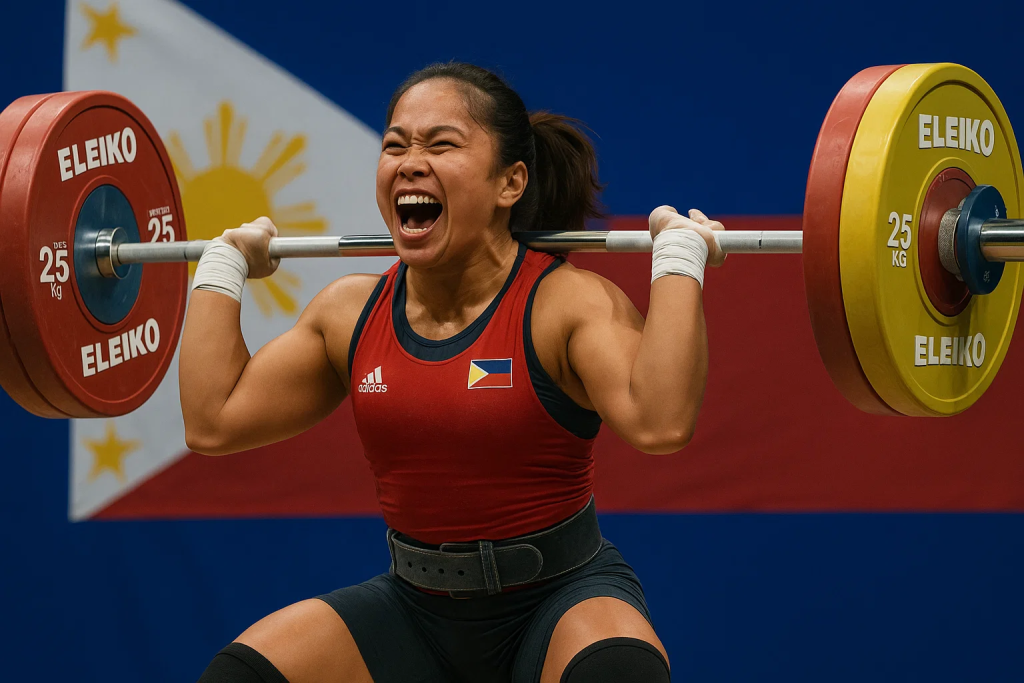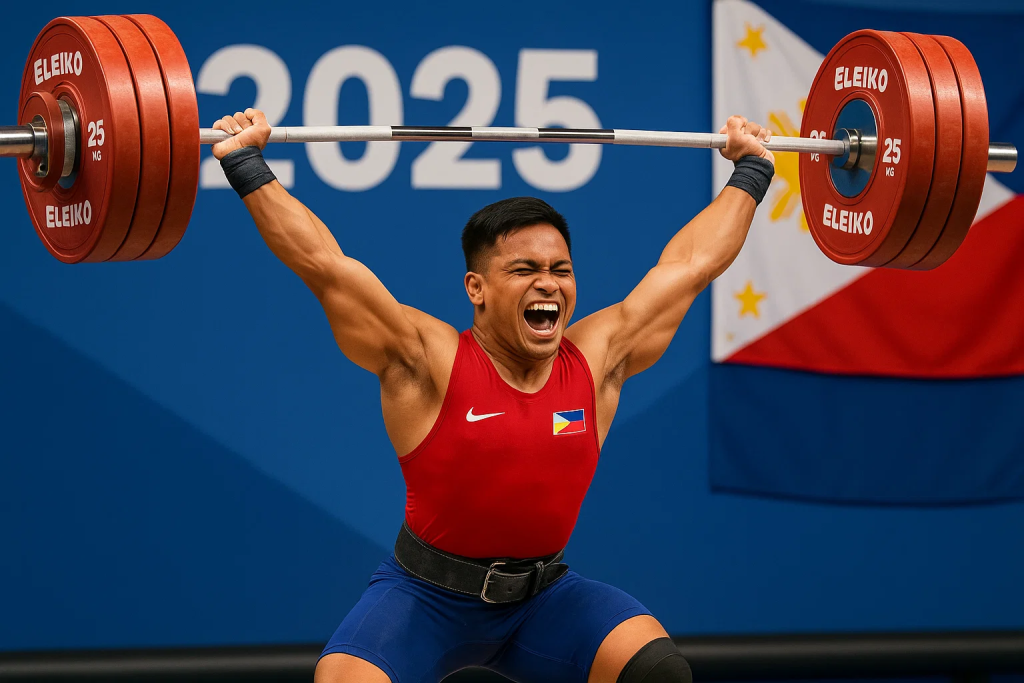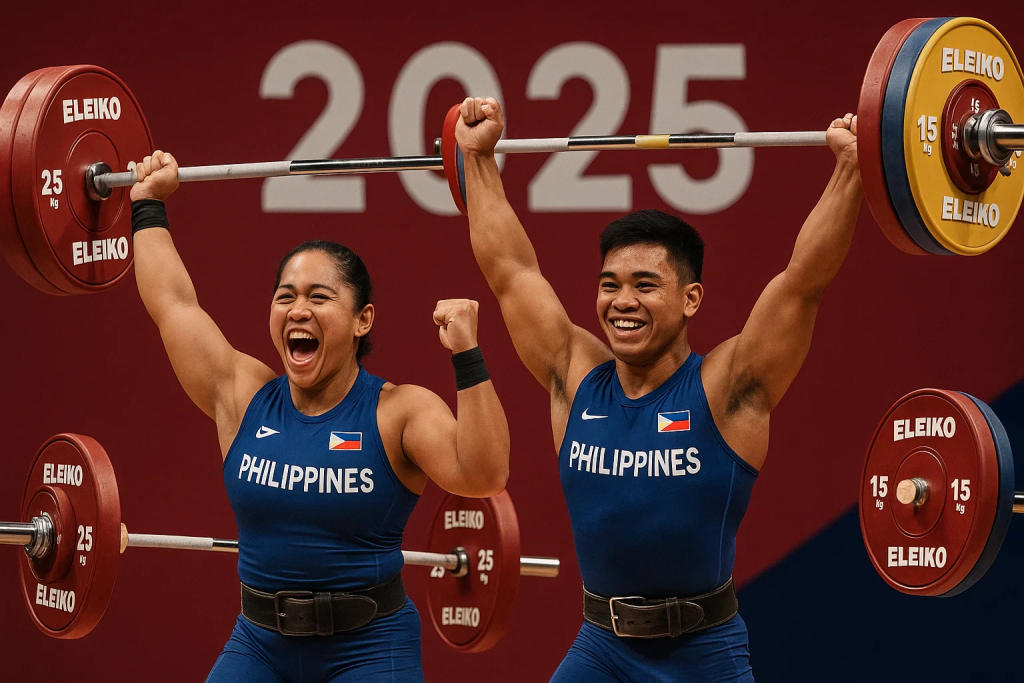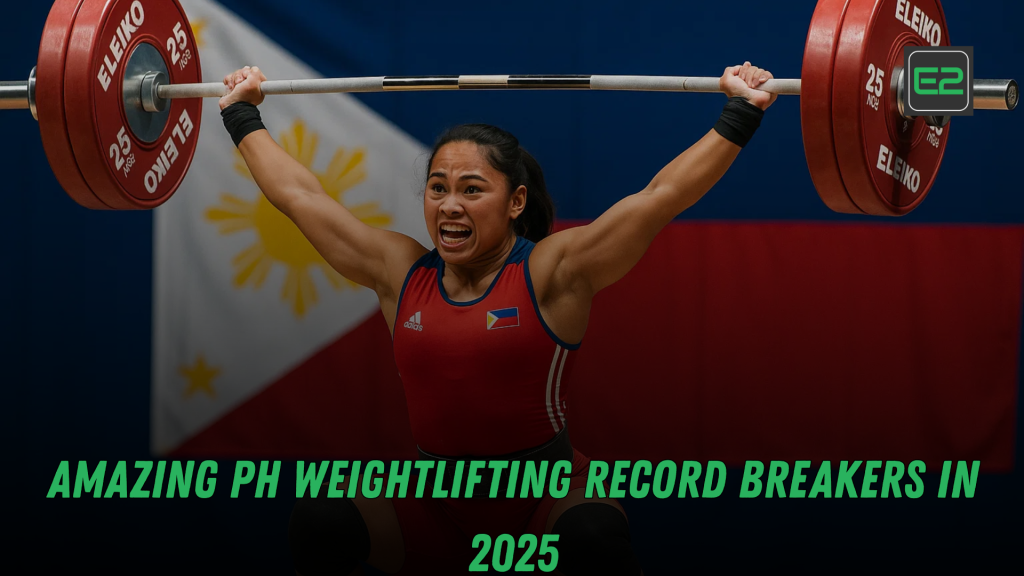Table of Contents
Executive Overview
Philippine weightlifting entered 2025 with a clear mandate: turn momentum into a movement. With a maturing talent pool and a national record book that keeps getting rewritten, the year has highlighted both breakthrough performances and hard realities—from podium surges at the Asian level to headline anti-doping news that resets expectations and safeguards integrity. On the platform, Elreen Ando (women’s 59 kg) and Rosegie Ramos (women’s 49 kg) delivered Asian-level medals, while a new generation of men’s lifters—most notably Albert Delos Santos in the 67 kg class—pushed national standards forward.
This long-form guide curates every 2025 highlight that matters, explains what those numbers mean, and builds an actionable blueprint for athletes, coaches, and fans to keep the records falling—responsibly and sustainably.

Snapshot: 2025 Weightlifting Results and Records That Moved the Needle
Asian Weightlifting Championships 2025 (Jiangshan, China)
The Philippines finished the continental meet with 2 silvers and 1 bronze (0-2-1), thanks to standout performances from Elreen Ando and Rosegie Ramos, who each picked up triple-silver totals in their events—a powerful signal that the Paris cycle experience is evolving into podium-consistent output.
The Record Book: What’s New and Noteworthy
The List of Philippine Records in Olympic Weightlifting reflects continued progression across multiple bodyweight classes. Among the most eye-catching 2025 entries: Albert Delos Santos establishing men’s 67 kg national records for snatch, clean & jerk, and total at the IWF World Junior Championships in Lima, Peru—a major talent signpost for the men’s program. The database likewise confirms the latest women’s marks in the 49–76 kg range, including marquee numbers from Elreen Ando and Rosegie Ramos based on international meets from 2023–2024 now underpinning the 2025 landscape.
Why these pages matter: The national-record ledger is the objective ground truth fans and media can reference when an athlete says, “I just broke the PH record.” Bookmark it; you’ll use it a lot during the 2025–2027 cycle.
Integrity Watch: The Vanessa Sarno Case
One of the Philippines’ most gifted lifters, Vanessa Sarno, accepted a two-year suspension from the International Weightlifting Federation in 2025, with an expected expiry in 2027. The development is sobering, but also an affirmation of the sport’s evolving anti-doping compliance environment. For the program, it’s a reminder that performance and integrity are inseparable.
Who the Weightlifting Record Breakers Are—and How They’re Changing the Game
Elreen Ando (Women’s 59 kg)
- Credentials: Multiple Philippine records in 59–64 kg, with a 59-kg total of 230 kg recorded during the Paris 2024 period (IWF ledger). In 2025, Ando’s triple-silvers at the Asian Championships showed she’s carrying top-tier continental form into the new cycle.
- Signature strengths: Efficient pull mechanics and competition temperament; a technician who rarely wastes attempts on big stages.
- Why it matters: The women’s 59 kg is one of the deepest global classes. Every medal Ando touches amplifies the Philippines’ credibility across the IWF landscape.
Rosegie Ramos (Women’s 49 kg)
- Credentials: National records in the 49-kg class and a 2025 Asian triple-silver, consolidating her status as the Philippines’ standard-bearer at the lightest Olympic women’s category. She’s also built a base of continental podiums after near-misses during the Paris qualification race.
- Signature strengths: Exceptionally crisp technique-to-bodyweight ratio in snatch and a poised clean & jerk under pressure.
- Why it matters: 49 kg is a showcase class for technical mastery. Ramos’ progression puts the Philippines in every medal conversation at Asian meets and certain IWF events.
Albert Delos Santos (Men’s 67 kg)
- Credentials: National records for snatch, clean & jerk, and total set at the 2025 IWF World Junior Championships (Lima), signaling that the men’s pipeline is catching up to the women’s side in record-making efficacy.
- Signature strengths: Explosive second pull and resilient front-squat recovery position, critical for heavy cleans at 67 kg.
- Why it matters: Philippine men’s weightlifting has long needed a flag-bearer to routinely threaten Asian finals. Delos Santos’ 2025 entries are a blueprint for what’s coming.
John Febuar Ceniza and the Men’s Light Classes
- Credentials: Owner of multiple long-standing national marks in the 55 kg and 61 kg categories, with prior Asian and global appearances that shaped the discipline’s modern standards in the Philippines.
- Why it matters: Ceniza’s resume is the scaffold younger lifters now climb—he showed Philippine lifters could live in the 55/61 kg top-flight conversation.
The Weightlifting Numbers, Explained: What Counts as “Record Breaking” in 2025?
Not all “records” are equal. Understanding what’s being measured—and where—helps you read 2025 headlines correctly.
- National Records (NR): Official Philippine standards in snatch, clean & jerk, and total, tracked by bodyweight category. These can be set at sanctioned domestic or international meets, as recognized by governing bodies. (See: the regularly updated national records ledger.)
- Continental Medals: Podiums at Asian events (e.g., Asian Weightlifting Championships) indicate regional competitiveness—often a predictor for world finals success.
- World-Level Outputs: Even when a PH lifter doesn’t podium at Worlds, A-group entries, 5–6 made lifts, and lifetime bests in either lift are key signals the program is correctly periodizing.
What Weightlifting 2025 Tells Us About the PH System: Three Structural Wins
- Women’s program maturity: The sustained capacity to produce Asian medalists (59 kg, 49 kg) means the women’s side has truly entered a repeatable pipeline phase, not a one-time surge.
- Men’s pipeline emergence: With Albert Delos Santos posting national records at a World Junior meet, and Ceniza anchoring experience at 55/61 kg, the men’s side is finally stacking depth.
- Integrity infrastructure tightening: The Sarno suspension underscores that national programs must combine performance ambition with robust compliance—education, testing, and governance.
Inside the Weightlifting: How Record Breakers Train (and How You Can Learn From Them)
Note: This section distills best practices common across elite programs; details vary by athlete.
1) Technical Economy
- Snatch: Wide-grip vertical bar path, patient pull to power position, turnover speed prioritized over reckless maxing.
- Clean & Jerk: Rack position mobility, front-squat strength, and jerk drive mechanics (dip depth consistency) are make-or-break at 90%+.
- Coaching application: Make video review a weekly ritual: draw bar path lines; track pull height and turnover timing.
2) Strength Periodization
- 4–6 week blocks cycling from accumulation (volume) → intensification (heavier doubles/singles) → taper (sharpening).
- Accessory lifts matched to sticking points: halting snatch pulls, front-squat pauses, jerk recoveries.
3) Mobility, Recovery, and Heat Management
- Thoracic, hip, and ankle mobility as daily minimum.
- Hydration + electrolytes, especially for SEA climates; RPE logging to catch non-functional overreaching.
4) Competition Rehearsals
- Attempt selection drills: simulate 1st/2nd/3rd lift choices; practice scratches and clock management under pressure.
- Travel stress inoculation: mock weigh-ins, time-zone micro-tapers.
2025–2027 Calendar Outlook: Where the Next Weightlifting Records May Fall
- Asian Weightlifting Federation (AWF) circuit: The 2025 continental meet is already in the books (Jiangshan); tracking the AWF results book helps map which classes are moving fastest (and where PH can pounce).
- World Juniors/Youth: With Delos Santos setting marks in Lima, the junior pathway is ripe for more NR assaults before athletes graduate to senior classes.
- Grand Prix/World Cups: These are ideal for incremental NR pushes (one lift at a time) without the Olympic-level nerve—still high stakes, but surgical.
- National Championships: Under-discussed yet crucial: a controlled attempt ladder at Nats often determines which records get shattered before Asian/World entries.

Weightlifting Program Playbook: How to Turn Record Breakers Into a Record-Breaking System
A) Talent ID & Local Hubs
- Feeder systems in Zamboanga and other strongholds should run quarterly combines: mobility, vertical jump, front-squat, hang power snatch metrics.
- Scholarships for weight-class-appropriate teens; parent education to combat myths about strength training.
B) Coach Development
- Annual licensing clinics with practical modules: attempt strategy, video biomechanics, injury differential (when to pull an athlete).
- Study circles around IWF results books—analyze winning attempts and build PH attempt archetypes for each class.
C) Sports Science & Medical
- Bloodwork twice yearly for national-pool athletes (iron panels, vitamin D, cortisol trends).
- Heat-stress protocols: individualized hydration/sodium plans; body-mass change thresholds for training adjustments.
D) Governance & Integrity
- Education-first anti-doping briefings before travel blocks; supplement audits; anonymous reporting channels.
- Internal “competition day” SOP for documentation: weigh-in logs, recovery protocols, secure storage of nutrition/supplements.
What Fans and Sponsors Can Do (Yes, You Matter)
- Follow the calendar and show up (or tune in) when PH lifters compete; engagement drives coverage.
- Adopt a weight class: Brands can own a story lane (e.g., “We power the 49-kg queen’s recovery tech”).
- Support club ecosystems: Equip local hubs with platforms, jerk blocks, plates, or travel grants for junior lifters.
Media Cheat Sheet: How to Cover Records Without the Gotchas
- Confirm the class and lift (snatch, C&J, total) and whether it’s NR/CR/WR.
- Cite the meet, date, and bodyweight class, then link the official results or national record list.
- If a previous record holder is suspended or inactive, stick to facts and official releases—avoid speculation.
Strong Call-to-Action
Athletes & Coaches: Take this week to run a three-point audit—(1) lifts with the highest NR upside in your class, (2) attempt-selection rehearsals under time pressure, and (3) a recovery/hydration re-plan for tropical heat. Publish your NR roadmap—own your narrative, and let supporters rally behind specific numbers.
Fans & Sponsors: Adopt a lifter, a club, or a weight class. Small, recurring support (plates, travel stipends, nutrition kits) has oversized impact. Ask your local gym what it would take to host a sanctioned meet in Q4—then help make it happen.
If you want a free “NR Attack Pack”—a printable attempt-planning sheet, warm-up timing chart, and a media checklist—say “SEND NR PACK” and include your weight class or club.
Sources & Notes
- Asian competitions: Medal table and meet reports for Asian Weightlifting Championships 2025 (Jiangshan).
- National records: Consolidated PH records list (men/women; updates through 2025 with IWF citations).
- Athlete pages & context: Rosegie Ramos profile; Vanessa Sarno page and 2025 suspension reports.
- AWF reference: Results resources and event documentation.
Disclaimer: Information reflects sources available as of September 2025. For athlete status, selection, and disciplinary matters, always consult official federation releases.
FINAL WORDS
The article presents a comprehensive look at Philippine weightlifting in 2025, framing the year as a pivotal moment where momentum must evolve into a sustainable movement. It spotlights breakout performances, maturing systems, and stricter integrity standards—positioning the country for a stronger 2025–2027 cycle.
Headline Performances. The Philippines’ biggest stage results came at the Asian Weightlifting Championships, where Elreen Ando (59 kg) and Rosegie Ramos (49 kg) each captured triple-silver performances, signaling consistent continental competitiveness in two of the sport’s most technical women’s classes. On the men’s side, junior lifter Albert Delos Santos (67 kg) set new national records in snatch, clean & jerk, and total at the IWF World Junior Championships in Lima, a crucial indicator that the men’s pipeline is now producing record-level outputs. Veteran John Febuar Ceniza remains a foundational figure in the lighter men’s categories (55/61 kg), providing a performance scaffold for younger lifters to climb.
What Counts as a “Record.” The article clarifies that not all “records” are equal. It distinguishes between national records (official Philippine standards for each lift and total), continental medals (regional competitiveness at events like Asian Championships), and world-level outputs (A-group entries, high make rates, lifetime bests)—helping fans and media read results accurately.

Integrity Watch. The piece does not shy away from the year’s sobering headline: Vanessa Sarno’s two-year suspension. Rather than sensationalize it, the article treats the case as a reminder that high performance and anti-doping compliance are inseparable, and that education, testing, and governance are core pillars of a credible program.
Urban Skateboarding: Philippines Hosts the Amazing Street League Stage
Why the System Is Working. Three structural wins emerge: (1) the women’s program has matured into a repeatable medal pipeline (not a one-off surge), (2) the men’s pipeline is finally stacking depth, with juniors like Delos Santos converting talent into national records, and (3) integrity infrastructure has tightened, aligning ambition with compliance.
How Record Breakers Train. A practical section distills elite habits: technical economy (clean bar paths, jerk-drive consistency), periodized strength blocks (from accumulation to taper), mobility and recovery in tropical climates (hydration, electrolytes, RPE logging), and competition rehearsals (attempt selection drills, time-clock management). It emphasizes weekly video review and targeted accessory work to fix sticking points.
Where the Next Records May Fall. The calendar outlook points to Asian Championships, World Juniors/Youth, IWF Grand Prix/World Cups, and National Championships as prime record-breaking venues. National meets, often overlooked, are highlighted as controlled environments where records can be strategically targeted before major international entries.
Turning Stars into a System. The program playbook proposes: talent ID combines and local hubs (with scholarships and parent education), annual coach licensing with hands-on modules (attempt strategy, biomechanics), sports-science basics (biannual bloodwork, heat-stress protocols), and governance upgrades (supplement audits, education-first anti-doping briefings, competition-day SOPs).
Community, Media, and Sponsors. The article urges fans to follow the calendar and engage during meets, and invites brands to “adopt” weight classes or clubs with tangible support (platforms, plates, travel grants). A media cheat sheet (verify class/lift, cite meet/date, link official results) promotes accurate coverage. The call-to-action challenges athletes/coaches to run a three-point audit (NR targets, attempt rehearsals, heat management) and offers a free “NR Attack Pack” for structured progress.
Frequently Asked Questions (FAQ)
1) Who are the headline PH record breakers and medalists in 2025?
2) Where can I verify current Philippine weightlifting records?
3) What happened with Vanessa Sarno in 2025?
4) Which meets matter most for future PH records?
5) How can clubs and sponsors actually help?
Fund platforms, plates, jerk blocks, and travel grants; host sanctioned meets; and support sports-science basics (bloodwork, hydration protocols). Tie support to clear NR targets to track impact publicly.
